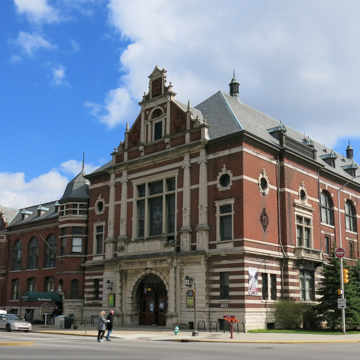You are here
Athenaeum
Das Deutsche Haus (The German House), or, as it has been known for the last hundred years, the Athenaeum, is one of the last remnants of the golden age of German-influenced culture and education in Indianapolis. Located in Lockerbie Square, the Indianapolis neighborhood became known as Germantown in the mid-nineteenth century due to the high influx of German immigrants following the recent revolutions in Europe. Largely well educated, these early immigrants wasted little time in organizing social clubs, musical societies, and reform groups. By the turn of the twentieth century, the large German community exerted a strong influence on the culture of Indianapolis.
Many of these organizations and societies constructed their own buildings, only a few of which remain, but other German clubs united to form the Socialer Turnverein Aktiengesellschaft (Social Gymnastic Society Stock Association), with the idea of constructing a large institutional building that would serve as a cultural center. This new structure would include a gymnasium for physical education and classroom space (embodying the healthy mind in a healthy body philosophy), along with a concert hall, an enclosed beer garden, and the Rathskeller, the oldest extant restaurant in the city.
In 1894, the architectural firm of Vonnegut and Bohn, whose principals were both sons of German immigrants, designed a German-influenced Romanesque Revival structure that housed the gymnasium, club and social rooms, classrooms, the Rathskeller restaurant and pub, and an outdoor beer garden with stage. The building is two stories high, with an attic and a full basement. The brick structure has a rock-faced stone foundation and slate-covered gable roof. It features towers at either end of its main facade, along with two gable ends on either side of the central entrance bay. Small, hooded, copper-domed dormers with dwarf spires punctuate the roofline as well. The main entrance is defined by a shallow porch with Doric columns and balustrade above.
In 1898, the facility expanded with the construction of another wing to the west. This new building contained a large concert hall, lobby, reception rooms, bowling alleys, and a large open veranda that would soon be glassed in to form a winter garden or conservatory. This German Renaissance Revival structure boasts a massive, steeply pitched hip roof; ornamented stepped gables; exuberant limestone banding; and art glass windows. The carved limestone along with some terra-cotta ornament—produced by the Indianapolis Terra Cotta Company—is the work of Estonian-born sculptor Alexander Sangernebo. The building was taller and larger than its residential neighbors, mostly two-story brick and frame houses, but related in scale to nearby institutions like the Little Sisters of the Poor’s Home for the Aged Poor and to the commercial buildings along the fast-developing corridor of Massachusetts Avenue, the northeastern diagonal avenue radiating out from the city center.
Das Deutsche Haus, as the building was christened, housed numerous social organizations, charitable groups such as the German Ladies’ Aid Society, and a financial institution. Its Musikverein (Music Society), founded in 1897, included two choirs and a large orchestra, the oldest in Indianapolis. In 1907 the Normal College of the North American Gymnastic Union moved from Milwaukee to occupy the building’s east wing. Indiana University incorporated the college in 1941 as its school of physical education; it remained in the building until 1970.
The anti-German sentiment that raged just before and during World War I led to the renaming of the building as the Athenaeum. After decades of decline following World War II, the nonprofit Athenaeum Foundation took ownership of the building, struggling at times with periodic rehabilitation and redevelopment. The Foundation’s mission is to preserve the historic structure in such a manner as to serve the community, and to sponsor numerous programs and events throughout the year. The Athenaeum still houses a variety of organizations, including, true to its roots, the offices of the Indiana German Heritage Society and the Max Kade German-American Center. The Rathskeller Biergarten remains a popular venue for live music within the Mass Ave neighborhood.
References
“Athenaeum (Das Deutsche Haus),” Marion County, Indiana. National Register of Historic Places Registration Form, 1973. National Park Service, U.S. Department of the Interior, Washington, D.C.
Selm, William L. “Athenaeum.” In Encyclopedia of Indianapolis. In Encyclopedia of Indianapolis. Edited by David J. Bodenhamer and David Gordon Vandestel. Bloomington: Indiana University Press, 1994.
Ziegler, Connie. “Vonnegut & Bohn.” In Encyclopedia of Indianapolis. Edited by David J. Bodenhamer and David Gordon Vandestel. Bloomington: Indiana University Press, 1994.
Writing Credits
If SAH Archipedia has been useful to you, please consider supporting it.
SAH Archipedia tells the story of the United States through its buildings, landscapes, and cities. This freely available resource empowers the public with authoritative knowledge that deepens their understanding and appreciation of the built environment. But the Society of Architectural Historians, which created SAH Archipedia with University of Virginia Press, needs your support to maintain the high-caliber research, writing, photography, cartography, editing, design, and programming that make SAH Archipedia a trusted online resource available to all who value the history of place, heritage tourism, and learning.

